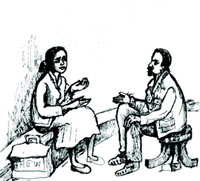23.6.2 What should you do after a patient starts ART?
Once patients start ART, they need to get support from you and the rest of the healthcare system to maintain adherence at all times. From the perspective of a Health Extension Practitioner, you need to follow-up patients closely and frequently in the form of regular visits or appointments. At these meetings, you should be vigilant of factors that can affect adherence significantly. This is particularly important at the start of ART, as there might be side-effects that may result in poor adherence. Discuss adherence at each visit and ask patients about new symptoms or any changes in their health status. If they have new symptoms, refer them to the health centre for better management. Reinforce the information and education about adherence given previously by assessing their knowledge and skills.

Providing support for adherence to HIV treatment and care involves creating a comfortable atmosphere where exchange of information between you and the patient is encouraged on each visit or appointment (Figure 23.4). As you talk to your patient, always use simple terms and visual aids, if available. Being non-judgmental and creating a trusting environment are essential in making the patient feel comfortable. Asking open-ended questions will enable you to assess whether the patient has understood the information you have provided in the current meeting or in earlier meetings. For example, ‘Sometimes it is difficult to take medications on time. Have you missed any pills since your last appointment?’, or ‘Why do you think you were unable to take your pills on time?’
Assessment of adherence should also be part of each visit as patients come for appointments, or as you visit them in the community. You should assess their percentage adherence (as explained in Section 23.3). If adherence is not 100%, try to get specific information about missed doses and work with the patient to determine why they encountered problems and which specific strategies might enable them to achieve 100% adherence. You should also attempt to recognise and acknowledge the difficulties of adherence and show a positive attitude. Patients should be regularly reminded about taking their medicine at the right time, but in a way that makes them feel motivated and encouraged to achieve 100% adherence to improve their quality of life.
If doses are missed, use the following rule to help your patients: If the drug is taken twice a day, the missed dose can be taken up to six hours later, but no later than that. For example, if the normal dose is taken at 7:00 a.m., the missed dose can be taken up to 1:00 p.m. Again, you can convey this message to the patient in simpler terms. For example, ‘If you miss a dose, take the dose as soon as you remember, but not if it is almost time for your next regular dose. Never take a double dose.’
Notify an HIV/AIDS healthworker at the nearest health centre if there are adherence difficulties, and discuss it with the healthcare team. In your regular follow-ups with PLHIV, help them to identify strategies to improve adherence. These may include using a treatment supporter, more home visits, either by you or by voluntary community health workers, a referral to home-based care, or encouraging patients to participate in social support activities such as participation in a PLHIV support group.
23.6.1 What should you do before a patient starts ART?
